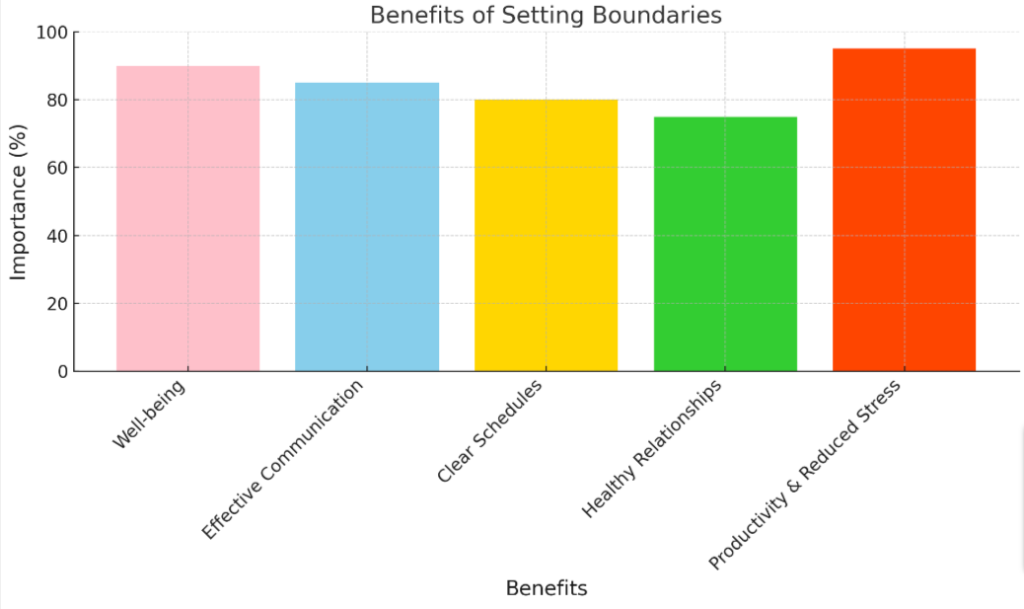Navigating Work Hours: The Art of Setting Limits
Struggling with work-life balance? You’re not alone. In fact, a recent study showed that over half of US employees feel burned out due to lack of boundaries between professional and personal life.
We’ve crafted this article to guide you in setting efficient time boundaries; helping bring back that much-needed equilibrium. Ready for positive change? Let’s dive in!
Key Takeaways
- Time boundaries refer to specific hours designated for different activities, helping maintain work-life balance and overall well-being.
- Setting boundaries boosts productivity, enhances work-life balance, reduces stress levels, prevents burnout, improves communication and self-discipline.
- Strategies for setting boundaries at work include effective communication, delegating tasks, establishing a clear schedule, and building professional relationships.
What Are Time Boundaries and Why Do We Need Them?
Time boundaries are limits and guidelines that we establish for ourselves in terms of when we should be working and when we should be taking time off. These boundaries are important because they help maintain a healthy work-life balance and contribute to our overall well-being, both personally and professionally.
Defining time boundaries
Time boundaries refer to the specific hours you designate for different activities throughout your day. This division may separate work time from personal time, or even break down professional responsibilities into manageable chunks.
Time boundaries can also cover when you are available for meetings, phone calls, or other forms of communication. By setting these limits and sticking to them diligently, we create a structured environment that not only boosts productivity but also makes space for leisure and relaxation.
A key component of sound work-life balance lies in defining strict yet feasible time boundaries which ensures mental peace while preventing burnout.
Importance of setting boundaries
Setting boundaries is a critical aspect of maintaining a healthy work-life balance. It allows individuals to manage their time efficiently and achieve maximum productivity within the confines of their scheduled work hours.
Establishing clear personal and professional lines not only aids in stress management but also helps prevent burnout by allowing for necessary breaks and personal time off. Especially with remote working situations becoming more common, setting boundaries can ensure respect for your private time while still fostering healthy professional relationships.
Moreover, laying out these limits contributes to self-discipline and lets you take control over your workload rather than feeling overwhelmed by it. Well-defined boundaries ultimately lead to improved overall well-being, highlighting the undeniable importance of this practice in today’s rapidly evolving workplace scenario.

Personal and professional benefits
Setting boundaries can offer immense personal and professional benefits:
- Boosts Productivity: Clear time management helps streamline tasks and increases focus on work.
- Enhances Work-life Balance: Maintaining distinct work and personal hours ensures a healthier equilibrium between occupational responsibilities and leisure activities.
- Reduces Stress Levels: Well-defined work boundaries help manage work-related pressures, leading to lower stress levels.
- Prevents Burnout: Taking regular breaks and time off prevents physical and mental exhaustion, reducing the risk of burnout.
- Improves Communication: Establishing limits promotes open dialogues about workload expectations, fostering better professional relationships.
- Encourages Respect for Personal Time: By designating personal relaxation hours, the importance of self-care is recognized.
- Promotes Self-discipline: Adherence to predetermined rules instills discipline, benefiting both personal growth and career progression.
- Enables Efficient Delegation: Boundaries facilitate an understanding of one’s capacities prompting effective task delegation when necessary.
- Offers Flexibility: Adaptability improves with clear boundaries as they can help identify when alternative work methods may be required.
- Leads to Higher Job Satisfaction: A balance between focused job efforts and time for rest can result in increased overall job satisfaction and morale among employees.
How to Set Boundaries at Work for a Healthy Work-Life Balance
Turn off work notifications outside of work hours, take breaks and time off, prioritize mental and physical health.
Turn off work notifications outside of work hours
To maintain a healthy work-life balance, it’s crucial to establish clear boundaries between your personal and professional life. One effective boundary is to turn off work notifications outside of work hours.
By doing so, you can create uninterrupted time for yourself and your loved ones, reducing stress and promoting relaxation. It allows you to disconnect from work-related matters and focus on personal activities or hobbies that bring you joy.
Prioritizing this boundary helps protect your well-being and ensures that you have dedicated time for rest and rejuvenation outside of the demands of your job.
Take breaks and time off
Taking regular breaks and time off is crucial for maintaining a healthy work-life balance. Here are some strategies to help you prioritize your mental and physical well-being:
- Schedule short breaks throughout the day to recharge and refresh your mind.
- Use your lunch break to step away from work and engage in activities that bring you joy or relaxation.
- Utilize vacation days or personal time off to disconnect from work completely and focus on self – care.
- Delegate tasks to colleagues when possible, so you can take guilt – free time off without worrying about unfinished work.
- Communicate with your team and set clear expectations regarding your availability during breaks or time off.
Prioritize mental and physical health
To maintain a healthy work-life balance and prevent burnout, it is crucial to prioritize your mental and physical health. Take regular breaks during the workday to rest and recharge.
Engage in activities that promote relaxation and well-being outside of work hours, such as exercise or hobbies. Make sure to get enough sleep at night to ensure optimum cognitive function.
By prioritizing your overall health, you can better manage stress levels and increase productivity in both your personal and professional life.
Strategies for Setting Boundaries at Work
Effective communication improves work relationships and ensures everyone understands their roles and responsibilities. Delegating tasks allows for a balanced workload, while establishing a clear schedule helps manage time effectively.
Read more to discover helpful strategies in setting boundaries at work.
Effective communication
Effective communication plays a crucial role in setting and maintaining boundaries at work. By clearly expressing your needs, expectations, and limits to your colleagues or superiors, you can ensure that everyone is on the same page and respects your personal and professional boundaries.
This includes being assertive about your availability during non-work hours, communicating about workload distribution, and discussing any concerns or issues that may arise. When communication flows smoothly and openly, it becomes easier to establish a healthy work-life balance while still achieving productivity and maintaining positive relationships with those around you.
Delegating tasks
Delegating tasks is an essential skill in setting boundaries at work. It allows you to distribute responsibilities and reduce your workload, promoting a healthier work-life balance. Here are some strategies for effective task delegation:
- Identify the right people: Assess the skills and capabilities of your team members to ensure that tasks are assigned to the most suitable individuals.
- Clearly communicate expectations: Clearly define the objectives, deadlines, and desired outcomes of each task to avoid confusion or misunderstandings.
- Provide support and resources: Ensure that those you delegate tasks to have access to the necessary resources and support needed to successfully complete their assignments.
- Trust in others’ abilities: Show confidence in your team’s capabilities by trusting them to accomplish their tasks without constant micromanagement.
- Regularly check-in: Stay involved in the process by providing regular check-ins and offering assistance when needed, but also allow space for autonomy and independence.
- Offer feedback and recognition: Recognize and appreciate the efforts of those who successfully complete delegated tasks, while also giving constructive feedback to help improve future performance.
- Learn from mistakes: If a task is not completed as expected, use it as a learning opportunity rather than placing blame. Assess what went wrong and adjust your approach accordingly.
Establishing a clear schedule
Establishing a clear schedule is crucial for maintaining a healthy work-life balance and maximizing productivity. Here are some strategies to help you set boundaries and stick to a consistent schedule:
- Define your working hours and communicate them to your colleagues.
- Prioritize tasks based on urgency and importance.
- Break down your day into manageable chunks of time dedicated to specific projects or responsibilities.
- Use digital tools like calendars or task management apps to organize and track your schedule.
- Avoid multitasking by focusing on one task at a time.
- Delegate tasks that can be handled by others, freeing up your time for more important work.
- Set realistic deadlines for yourself and communicate them to stakeholders.
- Take regular breaks throughout the day to rest and recharge.
- Resist the temptation to work outside of scheduled hours unless it’s absolutely necessary.
- Evaluate and adjust your schedule periodically to ensure it remains effective.
Building professional relationships
Building professional relationships is a crucial aspect of setting boundaries at work. By developing positive connections with your colleagues and superiors, you can establish mutual respect and understanding.
This allows for open communication and collaboration, making it easier to discuss and negotiate boundaries that work for everyone involved. Building professional relationships also fosters a supportive work environment where individuals feel comfortable expressing their needs and concerns without fear of judgment or retaliation.
Ultimately, strong professional relationships contribute to a healthier work-life balance by promoting cooperation, trust, and empathy among team members.
Conclusion
Setting boundaries is essential for maintaining a healthy work-life balance and overall well-being. By defining our time boundaries, we can prioritize our mental and physical health, effectively communicate with others, delegate tasks, establish clear schedules, and build professional relationships.
Remember to turn off work notifications outside of work hours, take breaks and time off when needed, and prioritize self-care. Setting these boundaries will help us foster healthier relationships both personally and professionally while maximizing productivity and reducing stress.
Importance of setting boundaries for overall well-being
Setting boundaries is crucial for maintaining overall well-being. When we establish clear limits and guidelines in our personal and professional lives, we can protect ourselves from burnout, stress, and overwhelm.
By setting boundaries, we create a healthy balance between work and personal life, allowing us to prioritize self-care and maintain our mental and physical health. Additionally, when we communicate our boundaries effectively with others, we foster healthy relationships built on respect and understanding.
Ultimately, setting boundaries empowers us to take control of our time, energy, and priorities so that we can lead fulfilling lives both inside and outside of work.

